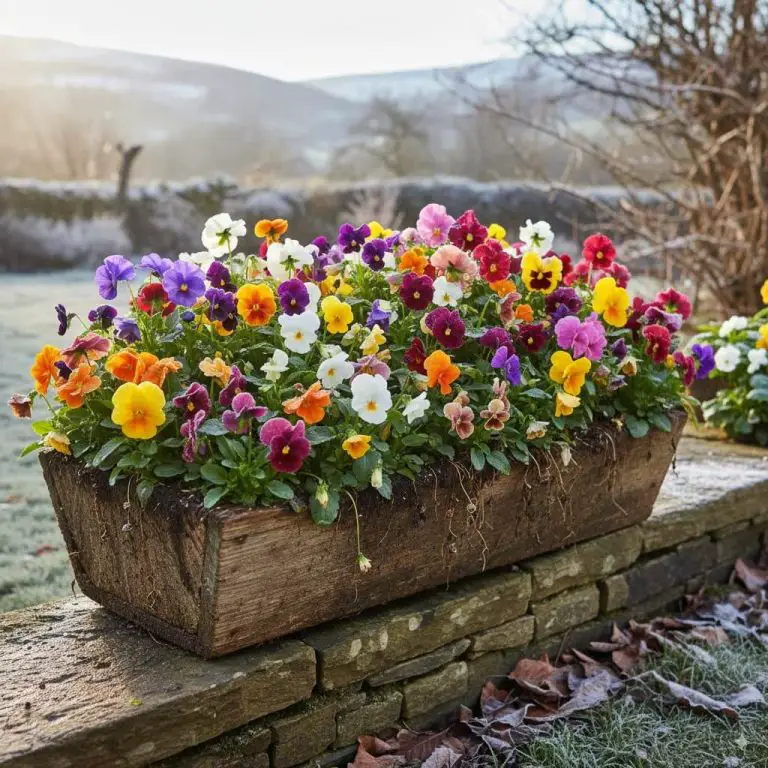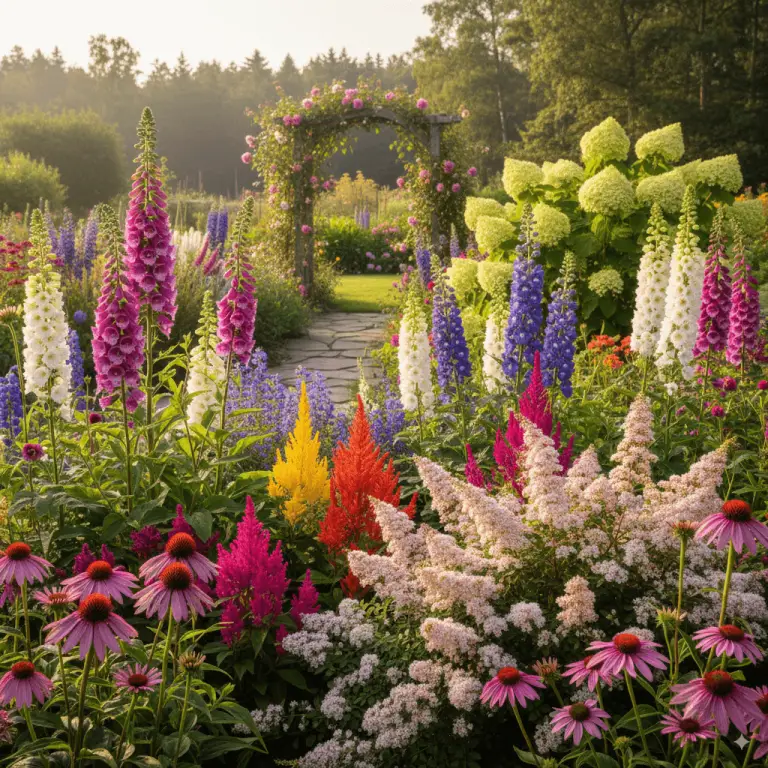Examples Of Flowering And Non Flowering Plants – Your Ultimate Guide
Have you ever looked at your garden in late fall and wished for more life and color? It’s a common feeling. We pour our hearts into nurturing beautiful blooms, but when their season ends, our outdoor spaces can feel a bit… empty.
I’m here to let you in on a little secret that transformed my own garden: the true magic lies in the partnership between different types of plants. I promise that by the end of this guide, you’ll understand exactly how to use examples of flowering and non flowering plants to create a garden that is vibrant, textured, and fascinating all year long.
We’ll walk through the fundamental differences, explore stunning examples of each, and I’ll share my best tips for combining them. Get ready to unlock a new level of garden design that brings structure, color, and life to your space in every season!
What's On the Page
- 1 What’s the Difference? Understanding Flowering vs. Non-Flowering Plants
- 2 Our Favorite Examples of Flowering and Non Flowering Plants for Your Garden
- 3 The Benefits of Blending Both Plant Types in Your Landscape
- 4 A Practical Care Guide for a Thriving Mixed Garden
- 5 Solving Common Problems with Flowering and Non-Flowering Plants
- 6 Frequently Asked Questions About Flowering and Non-Flowering Plants
- 7 Your Beautiful, Balanced Garden Awaits
What’s the Difference? Understanding Flowering vs. Non-Flowering Plants
Before we start picking out plants, let’s get our hands a little dirty with some basic botany. Don’t worry, I’ll make it simple! Understanding the core difference helps you appreciate what each plant brings to the table.
The Magic of Angiosperms (Flowering Plants)
Flowering plants, known scientifically as angiosperms, are the show-offs of the plant world. Their primary goal is to produce flowers, which then develop into fruits containing seeds. This is their clever way of reproducing.

🌿 The Companion Planting & Gardening Book (eBook)
Bigger harvests, fewer pests — natural pairings & simple layouts. $6.99
Get – $6.99
🪴 The Pest-Free Indoor Garden (eBook)
DIY sprays & soil tips for bug-free houseplants. $4.89
Get – $4.99Think of the bright petals of a rose or the sunny face of a sunflower. These aren’t just for our enjoyment; they’re brilliant advertisements for pollinators like bees and butterflies. They bring seasonal bursts of color, fragrance, and life to your garden, creating a dynamic and ever-changing landscape.
The Ancient Beauty of Gymnosperms & Others (Non-Flowering Plants)
Non-flowering plants are the strong, silent types. This diverse group includes gymnosperms (like conifers), ferns, mosses, and liverworts. Instead of flowers, they reproduce using other methods, such as spores or “naked” seeds found in cones (think pinecones!).
What they lack in flashy blooms, they more than make up for with structure, texture, and year-round greenery. They are the backbone of a great garden design, providing a lush, green canvas that makes the colors of flowering plants pop even more.
Our Favorite Examples of Flowering and Non Flowering Plants for Your Garden
Now for the fun part! Let’s explore some fantastic and reliable plants you can start with. This is your essential examples of flowering and non flowering plants guide, packed with my personal favorites that work well in a variety of climates.
Top 5 Flowering Plants for Effortless Color
These plants are chosen for their beauty, resilience, and pollinator-friendly nature. Don’t worry—these are perfect for beginners!
Roses (Rosa): The classic garden queen! From sprawling climbers to compact shrubs, there’s a rose for every space. They offer incredible fragrance and a long blooming season. Pro Tip: Choose a disease-resistant variety like the ‘Knock Out’ series for a truly low-maintenance experience.
Sunflowers (Helianthus annuus): Nothing says summer like a towering sunflower. They are incredibly easy to grow from seed and bring a sense of joy and wonder to any garden. Plus, their seeds are a treat for birds in the fall.
Lavender (Lavandula): This fragrant herb is a powerhouse. Its beautiful purple spikes attract bees, its scent is calming, and it’s wonderfully drought-tolerant once established. It thrives in full sun and well-drained soil.
Hydrangeas (Hydrangea): Known for their massive, show-stopping blooms in shades of blue, pink, white, and green, hydrangeas are a shade garden staple. They provide spectacular color from summer through fall. Did you know? The color of some hydrangea blooms can be changed by adjusting the soil’s pH!
Coneflowers (Echinacea): A native prairie plant that is tough as nails. Coneflowers are drought-resistant, love the sun, and attract a parade of butterflies. Their daisy-like flowers come in a range of colors and bloom for months.
Top 5 Non-Flowering Plants for Structure and Texture
These plants are the unsung heroes. They provide the lush, green framework that makes your entire garden look cohesive and professional.
Hostas (Hosta): The ultimate foliage plant for shady spots. Hostas come in a breathtaking array of sizes, textures, and colors—from deep blue-green to chartreuse and variegated patterns. They are incredibly low-maintenance and reliable.
Boston Fern (Nephrolepis exaltata): With its graceful, arching fronds, the Boston Fern adds a soft, feathery texture that few other plants can match. It’s perfect for shaded containers, hanging baskets, or moist garden beds.
Dwarf Alberta Spruce (Picea glauca ‘Conica’): This slow-growing conifer provides a perfect pyramid shape, offering vertical interest and evergreen color all year. It’s an excellent choice for adding formal structure to garden beds or containers.
Japanese Painted Fern (Athyrium niponicum ‘Pictum’): If you think ferns are just green, think again! This stunning variety features silvery fronds with hints of burgundy and blue. It instantly brightens up any dark corner of your garden.
Mosses (various): Often overlooked, moss can be a beautiful, low-maintenance groundcover for shady, damp areas where grass struggles to grow. It creates a tranquil, ancient-forest feel that is simply unmatched.
The Benefits of Blending Both Plant Types in Your Landscape
Knowing how to use examples of flowering and non flowering plants together is the key to a truly spectacular garden. The benefits go far beyond just looking pretty; you’re creating a healthier, more resilient, and more engaging outdoor space.
Creating Year-Round Visual Interest
The biggest benefit is easily the continuous visual appeal. When your summer flowers fade, the deep green of your conifers, the silvery foliage of your ferns, and the bold leaves of your hostas take center stage. This ensures your garden never has an “off-season.”
Supporting a Healthy, Eco-Friendly Ecosystem
A diverse garden is a healthy garden. Flowering plants provide nectar and pollen for bees, butterflies, and other pollinators. Non-flowering plants, especially evergreens and dense ferns, offer crucial shelter for birds and small wildlife during harsh weather. This approach is a cornerstone of creating sustainable examples of flowering and non flowering plants ecosystems in your own backyard.
Reducing Maintenance with Smart Planting
Many non-flowering plants, once established, are incredibly self-sufficient. By using them as the foundation of your garden beds, you create a stable structure that requires less seasonal replanting and upkeep. This allows you to focus your energy on the flowering annuals and perennials that provide those pops of color.
A Practical Care Guide for a Thriving Mixed Garden
Caring for a mixed garden isn’t complicated; it’s just about balance. Following these examples of flowering and non flowering plants best practices will set you up for success.
Watering and Feeding: A Balanced Approach
The golden rule is to group plants with similar needs together. Place your sun-loving, thirsty flowers in one area and your shade-loving, moisture-retaining ferns and hostas in another. Water deeply but infrequently to encourage strong root growth. A layer of organic mulch is your best friend—it conserves moisture for everyone!
Pruning for Health and Beauty
For flowering plants, “deadheading” (removing spent blooms) encourages more flowers. For non-flowering plants like ferns and hostas, pruning is mostly about tidying up. Simply trim away any brown or damaged fronds or leaves at the base to keep the plant looking fresh. Evergreen conifers rarely need pruning beyond removing a dead or broken branch.
Sunlight Savvy: Placing Plants in the Right Spot
This is the most critical tip in any examples of flowering and non flowering plants care guide. “Right plant, right place” is a mantra for a reason. Before you even dig a hole, observe how the sun moves across your yard. Full-sun spots are for roses and coneflowers, while the dappled light under a tree is perfect for hostas and Japanese Painted Ferns.
Solving Common Problems with Flowering and Non-Flowering Plants
Even seasoned gardeners run into issues. Here’s a quick look at some common problems with examples of flowering and non flowering plants and how to troubleshoot them.
Why Aren’t My Flowering Plants Blooming?
This is a frequent frustration! The most common culprits are:
- Not enough sun: Most flowering plants need at least 6 hours of direct sun.
- Too much nitrogen fertilizer: This encourages lush green leaves but no flowers. Switch to a fertilizer higher in phosphorus (the middle number on the bag).
- Improper pruning: Some plants, like hydrangeas, bloom on old wood. Pruning at the wrong time of year can remove the flower buds.
Dealing with Pests on Foliage-Focused Plants
Slugs and snails love hostas. A simple, eco-friendly solution is to place a shallow dish of beer near the plants; they are attracted to it and will drown. For aphids or spider mites, a strong spray of water from the hose or an application of insecticidal soap is often all you need.
Brown Tips on Ferns and Hostas: What It Means
Crispy, brown edges on the leaves of shade plants usually point to one thing: not enough water. While they love shade, they also prefer consistently moist (but not soggy) soil. Ensure your mulch layer is thick and check the soil moisture regularly, especially during hot, dry spells.
Frequently Asked Questions About Flowering and Non-Flowering Plants
Can I grow non-flowering plants indoors?
Absolutely! Many popular houseplants are non-flowering and prized for their foliage. Ferns, snake plants, and pothos are fantastic examples that thrive indoors and help purify the air.
Are all non-flowering plants evergreens?
No, this is a common misconception. While many conifers are evergreen, plenty of non-flowering plants are deciduous. For example, hostas and many ferns die back to the ground in winter and re-emerge with fresh growth in the spring.
How do non-flowering plants reproduce?
It’s fascinating! Ferns and mosses reproduce via microscopic spores, which are often found on the underside of their leaves. Conifers, like pine trees, produce seeds in cones. It’s a more ancient system than flowers, but just as effective!
What are the most low-maintenance flowering plants for beginners?
For a beginner looking for reliable color, I always recommend Marigolds, Zinnias, and Coneflowers. They are very forgiving, handle heat well, and bloom profusely with minimal fuss.
Your Beautiful, Balanced Garden Awaits
Creating a garden that captivates in every season isn’t about having a “green thumb”—it’s about smart, thoughtful design. By now, you see that the secret isn’t choosing one type of plant over the other; it’s about celebrating the unique beauty of both.
The steady, textured grace of non-flowering plants provides the perfect stage for the vibrant, fleeting beauty of your favorite blooms. They work together in perfect harmony to create a garden that is more than just a collection of plants; it’s a living, breathing work of art.
So go ahead, start planning. Pick a fern to soften a shady corner or a dwarf spruce to add some height. I promise that when you embrace the power of both, your garden will thank you for it. Happy gardening!
- African Violet Blooms Dried Up – A Pro Gardener’S 5-Step Rescue Plan - October 16, 2025
- African Violet Care Tips – Your Ultimate Guide To Lush Leaves & - October 16, 2025
- African Violet Annual Or Perennial – Unlocking Their Lifelong Blooming - October 16, 2025


